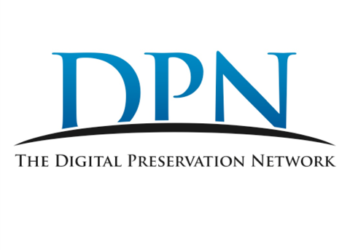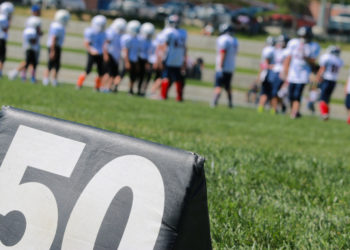Twenty years ago, in his infamous book, Double Fold: Libraries and the Assault on Paper, Nicholson Baker ranted about the inadequacies of microfiche and microfilm as surrogates for original copies of print newspapers. At the time, much was made of his investigation into newspaper preservation and archiving practices. A starred notice in Kirkus Review concluded, “If even half of what he alleges is true, some of America’s most honored librarians have a lot of explaining to do.” Baker made clear his belief that librarians and archivists were putting their professional or institutional needs before the needs of those who sought to actively engage primary source materials.

A reviewer in the Canadian Journal of Communication noted with concern,
Double Fold is also a salient text for media historians because it grapples with how mass disbinding/microfilming policies affect media-history scholarship. Baker points out throughout his book that microfilm effectively strips the newspaper from its historical context in many ways. On a purely visual level, the microfilm format destroys the experience of reading a newspaper into an enforced linearity.
Migration of the content from paper to microfilm thus, the reviewer argued, limits its value to the researcher.
The controversy arising from the 2001 publication of Double Fold was such that the Association of Research Libraries (ARL) provided talking points to its members for countering Baker’s arguments, as well as a useful FAQ. In an issue of First Monday, Richard Cox, at the time a professor at the University of Pittsburgh School of Information Sciences, countered Baker’s accusations of library indifference and negligence by noting the costly challenges of preservation and the very limited resources made available for the purpose. The debate was discordant and very public.
I was reminded of the friction created by Baker a week or two ago when I noticed buzz associated with a roundtable discussion at the Modern Language Association (MLA) Annual Meeting. As part of that discussion, Mike Furlough, Executive Director of HathiTrust, questioned whether 1995 recommendations from the MLA about primary records (meaning physical copies of primary source materials) retained their relevance in 2021.
The original 1995 MLA statement was crafted when digitization was gaining popular momentum. Specifically, it recommended collaboration with libraries, “leading toward (1) the maximum retention and preservation of textual artifacts, as well as a refining of the selection criteria necessarily entailed, and (2) the use of responsible procedures in the creation and identification of photographic and electronic reproductions based on those artifacts.”
In support of the statement, the MLA published a special issue of their journal, Profession, that gathered papers emphasizing the knowledge to be gleaned from examination of physical forms. Scholars of the book feared that libraries would be more concerned with removing books than with their preservation and wanted to make clear to their colleagues that a digital surrogate could not serve all research requirements. Not having attended the 2021 MLA session, I can’t say whether the objective of Professor Michael Hancher’s proposed session was simply to reiterate that concern or not; however, his 145-page bibliography on the topic of weeding (or deselection) is impressively thorough in documenting the pros and cons put forward by researchers and librarians in the humanities.
Via Twitter, Furlough made public a rough script of his roundtable comments on the same day as the event itself (Jan 10). He emphasized that, of course, libraries continued to be deeply concerned with preservation of primary source materials. However, the work of print preservation requires a continuous supply of various resources (funding, space, staffing, etc.), all of which are currently under scrutiny by cash-strapped institutions dealing with effects of a pandemic. There is no comfortable solution to the problem, given the realities of the “existential financial threats” to an academic library’s parent organization. Furlough reminded his audience that there is not now nor has there ever been a way for a library to keep everything. He put three blunt questions to the audience:
- Where exactly do the library’s resources come from?
- How much money does your university allocate to the library?
- How much of that money is earmarked for the continued preservation of items that each have their own artifactual value, versus new books that keep getting published and that publishers hope libraries will buy?
For decades, there has been tremendous growth in the book and journal publishing market, both in terms of number of titles and pricing. Libraries have exerted significant energy in ensuring that collections remain current, while wrangling with publishers over the costs. Scholars and researchers may be somewhat aware of those struggles, due to the work of open access advocates, but their understanding is less robust that weeding of the library’s collection is a necessary solution. To researchers in monograph-heavy disciplines, where acquisitions have slowed due to budget concerns, getting rid of older titles may signal deprivation. Whether researcher or librarian, whose expertise finally determines the depth and shape of our body of knowledge? What formats, what versions of established knowledge survive on a long-term basis? There have been any number of case studies in the library literature about how best to manage a deselection process without creating undue alarm or alienation.
Here is where our information community gets caught between the rock and the hard place. The back and forth at MLA between librarians and scholars represents a negotiation over the current support provided to researchers in book-oriented disciplines. To assuage their concerns, stakeholders (scholars, librarians, and, yes, publishers) need to better collaborate on delivering the highest quality of access to and preservation of all of the content formats that the 21st century encompasses.
Roger Schonfeld of Ithaka pointed out recently in this blog a misalignment between the services offered by publishers and librarians and actually meeting researchers’ needs, deploring the lack of a user-centric architecture. The information community may be trying to satisfy user needs, but there are large gaps that need to be bridged. Relative newcomers to the space who try to bridge those gaps in innovative ways may be called out for not adhering to existing practices or rules, regardless of whether those community arrangements still make sense. Sense could be restored through legal as well as technological means, but to do so requires investments of time and money as well as a long-term commitment to innovation.
As a final anecdote, there was a moment of irony for me this month in revisiting Double Fold. Whether because it had been lent out to a friend or placed in storage, I couldn’t put my hands on the physical copy that Amazon assured me I purchased years back. Annoyed but impatient, I purchased the Kindle edition, only to discover that it was indeed an inferior surrogate for the print. I had wanted to consult Baker’s epilogue, which contains the recommendations he suggested librarians adopt for a more satisfactory resolution moving forward. But a basic ebook feature was missing. Vintage Books, a subsidiary of Knopf and the publisher responsible for the digital version, had neglected to include a linked table of contents, one of the most basic navigational tools on which a reader or researcher might expect to rely. A cost-saving measure adopted by a publisher in transitioning backlist titles into the digital age? Quite possibly. But not a satisfactory solution for the end user.
This is not about questioning the expertise of either library or publishing professionals; stakeholders are doing their best to deliver services in a rough environment. But transitional solutions should not be allowed to become the norm if they fail the requirements of the user. The scholarly community is happy to tell us of their requirements; are we willing to listen?
Discussion
16 Thoughts on "Revisiting Nicholson Baker and Retention of Print"
This takes me back in time to when Nicholson Baker spoke at the Utah Library Association’s 2001 annual conference and I handed him a copy of the June 2001 issue of Searcher, with the very wonderful editorial by the inestimable Barbara Quint. I think the digital version (https://www.infotoday.com/searcher/jun01/voice.htm) of the editorial keeps the flavor of her voice, even down to the caricature. C-SPAN actually filmed me handing him the magazine (https://www.c-span.org/video/?164326-1/double-fold-libraries-assault-paper).
I had overlooked that piece by Barbara Quint, but I absolutely agree with her focus on ensuring access and use. (See this particular quote where she is addressing Mr. Baker, “The great breach between your image of librarianship and ours comes when we place that “artifact” in peril, as we do every moment of every day and eagerly, by trying to circulate it. We believe in access. We only acquire and retain material because of its potential for use. The difference is simple. When a librarian looks at an empty shelf, they say, “There’s a job well done.”)
Thank you for posting the link to Quint’s editorial. Her intelligence and humor still comes through and I consider myself lucky for having known and been edited by her. I miss her writing and hearing her pontificate, educate, and entertain. She was truly one of a kind.
For me, the conversation at MLA is a critical one, but it also isn’t clear to me that the objections of a handful of professors will stand much of a chance of having substantial impacts on library budgets. Supportive or not, the active scholars just don’t seem to control the budgets. Our professors rarely have the information, opportunity, or interest to substantially influence budgets at the level needed to support particular library activities at the scale required to build/maintain remote storage and radically upsize digital preservation activities in the near and forever term. Of course, it doesn’t help that these cries for keeping every scrap of paper the library ever touched are largely from scholars who do not bring in major research funding (what is the F&A at your institution?).
The ongoing disconnect between what institutional scholars may want from libraries and what the institution will do beyond token moves is a larger symptom of the perfectly rational delegation of responsibility. Division of labor is efficient and effective. Libraries benefit from it, and we have grown to value our autonomy. That is, let’s keep in mind that it isn’t necessarily the “scholars” with whom us libraries are negotiating for the critically important “continuous supply of various resources (funding, space, staffing, etc.)” necessary to physically and digitally preserve materials.
While they may or may not have been scholars at some point, we are facing administrators who are allocating resources in the name of shifting and evolving priorities, and beyond the unlucky few who might serve a term on a budget committee, our scholars are are rarely given substantial information at a granular level in relation to the choices their provosts and other leadership are facing. How much does it cost to build and retain faculty more inclusively? Beefing up information security? A new arts center? Replacing aging infrastructure and dealing with substantial deferred maintenance?
Continuing to lobby our major donors (i.e., Board of Trustees members) and our provosts probably continues to be our most effective strategy. But which library can honestly say that much-needed offsite storage facility will sound as sexy as a new area of special collections excellence, updating an old library space or creating a digital scholarship program?
Print retention programs, coupled with massive and cooperative digital preservation and access seem to offer a reasonable path forward. Working together, libraries can focus our resources on fewer physical copies and allocate more resources per item. Although all of this is still somewhat in its infancy, ReCAP, FLARE, Maine Shared Collections, and the UC RLFs offer glimpses into sustainable, effective and efficient models.
Perhaps the case we need to make is more of a national one. After all, scholarship based on historical publishing will be using the Library of Everything, no matter the format, no matter the location.
Many academic and research libraries are addressing just the kinds of concerns addressed here in the form of shared print programs which create collective collections of print monograph and journal titles that the libraries commit to retain. A number of these programs in the U.S. are collaborating at the national level through the Partnership for Shared Book Collections and the Rosemont Alliance for Shared Print.
A quick search of the program with which I work, the Eastern Academic Scholars’ Trust (EAST), indicated that we are currently retaining 6 copies of Double Fold by Nicholson Baker at academic libraries in Massachusetts, New York, Maryland, and Pennsylvania. The title has also been digitized by both HathiTrust and Internet Archive.
I agree completely with Mike Furlough’s assessment of today’s academic library environment and the fact that libraries have never been able to “keep it all”. But, by working collaboratively – with the support of their faculties and administration – libraries can do much to ensure that our print past (and future) are protected and preserved.
If only people were reading the books. Even with an unlimited budget (who has that?) to preserve every scrap of paper ever written (does it all merit being preserved?), we can’t make students (or even some faculty) read. Our problem is much, much larger than storing it all away somewhere.
As one of the villains quoted in the book, I can confirm that I personally learned much from the Baker experience—not the least being to never, ever engage in a telephone conversation with a known wannabe library muckraker when your nationally respected supervisor is away.
But professionally, the greater lesson has been to notice certain standards and practices behind the scenes in our technical services that inhibit (to put it nicely) the user experience. For all of the focus on the primacy of the user in library school, it is very easy to become distanced in our quotidian duties such that we become servants of the standards and practices that are meant to serve us all.
Finally, it is important to note that, popular press aside, there were contemporaneous voices from within the academy with a critical view of the treatment of physical materials in libraries and archives, most notably G. Thomas Tanselle.
These are issues we have been talking about for a long time. On July 11, 1994, I delivered a talk at a panel discussion of the annual meeting of the Association of American Law Libraries with the title “To Save or Not to Save: That Is the Question” in which I canvassed the challenges scholars, publishers, and libraries were facing in those early days of digitization efforts. It appears that some of these challenges still face us today. Here is a link to the paper: https://scholarsphere.psu.edu/resources/64499f12-89c8-4977-a959-c9b8de75bf6f
The claim is made in passing in this post that the number of books published by scholarly presses has kept increasing. I would like too see some data. Back in the late 1980s my mentor, Herbert Bailey, Jr., did a study for the ACLS that documented the increasing danger of having some fields of scholarship become “endangered species” owing to the increasing pressures on the budgets of university presses, which reacted by cutting back publishing in fields where sales were poor, and I wrote an op-ed for The Chronicle of Higher Education in 1995 showing how university presses had taken over the publication of “:mildest” books from commercial publishers that were abandoning them because of the market pressures they were under, substituting these mildest titles for more traditional monographs while not expanding their lists. Later on, in the early 2000s, it became clear that the revised dissertation was under threat in particular as more libraries began to cut back on purchases of books that originated as dissertations in favor of subscribing to the ProQuest dissertation database. These pressures intensified because, at least until the time I retired in 2009, university presses were NOT putting out more titles but either holding steady or cutting back. Perhaps commercial publishers like Sage, Rowman and Littlefield, Bloomsbury Academic, Lexington, and others have been increasing output, but I doubt that university presses have been.
This controversy made me focus my attention on Baker. For a few years he thought he could prove his point by storing issues of a periodical. Of course he finally realized that just storing an item is costly so he sold it to an institution. Thereafter we never heard from him again on this issue. But we did hear from him about World War II in which he questioned whether the United States should have ever entered the war. I lost any respect I had for him after that. That made me realize Baker was just an opportunist seeking publicity for himself the way any author does.
Agreed that there’s an additional irony in Baker finally having to arrange for his newspaper collection to go to Duke. It would be fascinating to me to learn whether there were any specific requirements that he made in transferring it over to an institution, such as preservation in perpetuity or something similar.
We dug up the agreement, and here is a summary of the general terms, and a few additional observations. Thanks to Andy Armacost, Duke’s Head of Collection Development and Curator of Collections, Rubenstein Library for digging this up and providing this so quickly.
General terms:
– The collection came as a gift to Duke, with the agreement signed in late 2003 and with the terms becoming effective in 2004
– Duke agreed to store the collection in a closed stacks environment and to serve the collection in the context of a secure reading room
– Copies are permitted, but there are limits on the alteration of the originals to facilitate this work. This is written with the intent to privilege the preservation of the original materials.
– Duke agrees to maintain the collection as a collection and not remove individual titles from the context of the collection
– If Duke is unable to maintain the collection as a whole at some point in the future it may seek another suitable repository
Some observations:
– The collection is stored in the Duke Library Service Center with temperatures close to 55 degrees
– The collection gets regular requests (for in-person use and for imaging). The collection also gets used in the context of Library instruction sessions. There has been special interest in color printing as represented in certain titles/sections and there has been special interest in some of the comics represented in the collection.
– The collection has been featured in at least one movie, https://www.josephpulitzerfilm.com/
– The collection has attracted financial support from donors
I don’t think this is the appropriate response to the issues he raises. I know nothing of this position regarding the war; it is the first I have heard of it and not knowing precisely what was said and why I am not in a position to form an opinion. But unlike some moral questions – should Birth of a Nation be taught in school film classes? – this supposed position on the war has nothing to do with the issue at hand and there is no reason for it to color our response to his arguments. It sounds like a rather glib dismissal, as is “thereafter we never heard from him again on this issue.” He’s a writer who writes essays on different topics. Moving on to the next one does not invalidate the previous one. I’m sorry to sound pedantic and nit-picking, but I think, in light of the political events of the past four years in particular (although these were just the outgrowth of a long-festering cancer), we should all avoid sounding like Republican senators explaining away Trump and claiming the blame is really the Democrats’, and instead address issues directly and honestly in the nuts and bolts of our language and arguments.
Thank you for this, Jill: “transitional solutions should not be allowed to become the norm if they fail the requirements of the user. The scholarly community is happy to tell us of their requirements; are we willing to listen?” I was part of the 2021 MLA panel, where I think the key takeaway was a need for better, more collaborative conversations among librarians and humanities faculty about the future of print collections, especially with regard to budgets and the very real pressures on humanities research support across the board. Discussions about print management can quickly get polarized and people stop listening. How can we work together in meaningful ways to chart a course forward? One idea: as a counterpart to subject librarians who work with departments, perhaps humanities faculty could be formally embedded in the library for a season, allowing them to be part of budgeting and the hard choices it requires.
Andrew, I am so glad to hear from someone who was actually in the room for the discussion. The idea of embedding faculty in the library is an interesting one, if there were interest from the faculty to participate.
Are most books these days produced from a file or files submitted by the author, rather than type-set from typed copy? Or rather, by processing the author’s electronic submission through some sort of publishing software (I’m thinking of the process for Kindle Direct Publishing, but I assume the basics are similar for other formats.) What is the proper status of these files–do they warrant preservation?
To William Harshaw’s specific question about the digital files involved in book publishing, I recently prepared a report on exactly this question (and the challenges for preservation) with the Book Industry Study Group and Mellon Foundation. Entitled Books.Files: Preservation of Digital Assets in the Contemporary Publishing Industry, it is available here as a PDF:
https://drum.lib.umd.edu/handle/1903/25605
With regard to the article above, I would suggest it also raises the question of digital materials as “primary records,” in the MLA’s (insufficient) parlance. Thank you.



